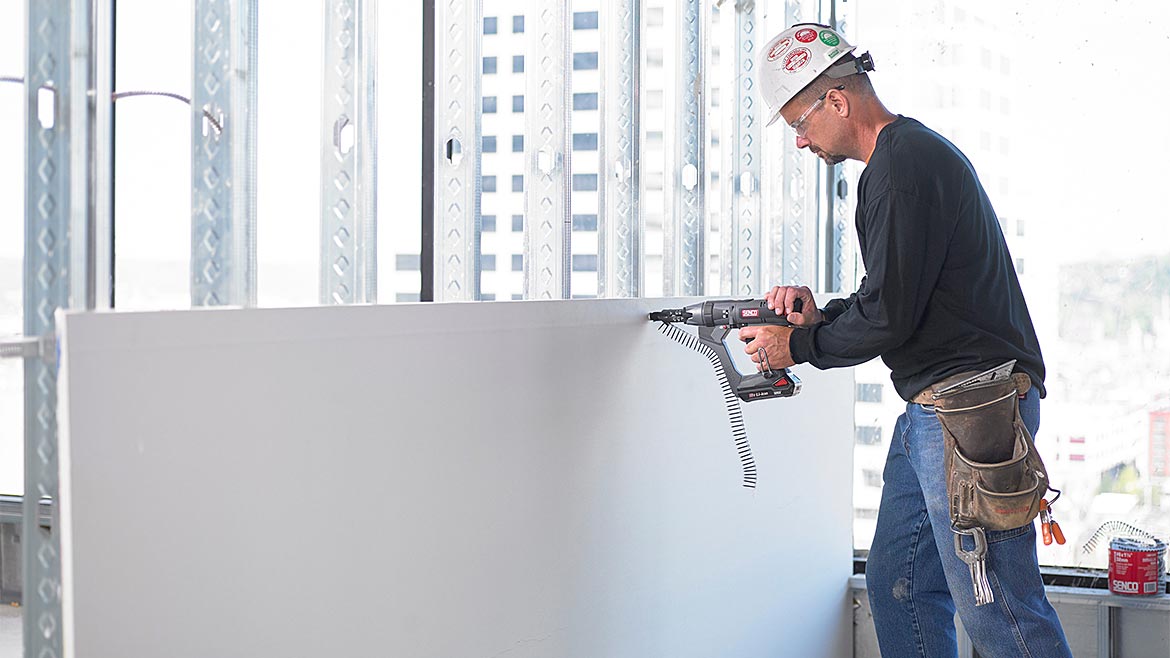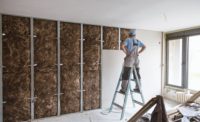Fasteners play a crucial role in ensuring the stability and longevity of wall and ceiling installations. Whether you're working on a professional job or a DIY project at home, choosing the right fasteners and using them correctly is essential. Using the right fasteners prevents sagging, cracking, and other common issues that can arise over time. In this guide, we'll explore the key aspects of fasteners and the different types for walls and ceilings to help you achieve a successful installation.
Drywall Installation and Fasteners
When installing drywall, you have options for fasteners:
1. Drywall Screws: Drywall screws are specifically designed for attaching drywall to wood or metal studs. Depending on the substrate used, you’ll select either a sharp point for wood or drill point for metal. Your substrate also determines whether you use fine threads (metal) or course threads (wood). The tip and thread type grip the substrate securely while the head holds it in place. Screws are available in various lengths to accommodate different drywall thicknesses.
2. Drywall Nails: Nails are another option for attaching drywall. They are typically used when speed is essential or when cost is a significant concern. However, they may not hold as securely as screws over the long term. Nails can also lead to "nail pops" if not driven properly.
Screws are typically the better option for drywall installation, which we’ll explore in the next section.
Anatomy of a Screw
To better understand the role of screws in wall and ceiling installations, let's delve into the anatomy of screw design:
1. Head: The head is the top of the screw and is available in various shapes. The most commonly used drywall screws are Bugle heads with a Phillips drive. The head provides a surface for driving the screw into the material and distributes force. What you’ll want to pay attention to for drywall is whether the screw is counter sinking and non-counter sinking. The difference is where the head sits once the screw has been driven. For drywall, you’ll want counter sinking screws that are designed so the top of the screw head sits flush with or below the material being fastened. When counter sinking, you do not want to break the paper. Having a high-quality tool can help ensure proper depth.
2. Threads: The threads are the spiral ridges along the shaft of the screw responsible for gripping the material and creating a secure connection. As mentioned above, the type of threads can vary and the substrate determines what kind you need. Three measurements determine the size of each screw, and you should consider all three before starting a job: shank diameter, threads per inch, and length. For example, a screw listed as #10-16 by 3/4 inch means a screw with a #10 shank that is 16 threads per inch and 3/4 inch length.
Coarse thread screws, such as drywall screws, typically leave out the threads per inch. On those, you’ll see measurements like #6 x 1¼ inch instead. For the majority of drywall applications, #6 or #8 screws are going to be used.
3. Shank: The shank is the body of the screw and includes both the smooth section of the screw between the head and shaft that where the threads are. It is the first number in a screw’s measurement such as #8, #10, etc.
4. Point: The point of the screw is the tapered end that initiates the drilling action when the screw is turned. Different types of points are designed for specific materials. For drywall, you’ll want a sharp point if you’re using a wood substrate or a self-drilling point if you’re attaching the drywall to metal.
5. Material: Screws can be made from various materials, such as steel, stainless steel, or brass. Drywall screws are most commonly carbon steel. The choice of material depends on factors like corrosion resistance and load-bearing capacity.
6. Coating: These coarse-thread screws typically feature zinc coatings, which better protect against rust compared to phosphate coatings.
The most common drywall screws are 1¼ inch. Use 1¼-inch drywall screws to secure 1/4-inch drywall installed on wood-stud walls. For thicker drywall, such as 5/8 inch used in ceilings, you’ll want to use 1 5/8 inch to prevent sags. To secure that added weight, use #6 screws measuring 1 5/8 inch to allow 1-inch penetration into the wood.
To ensure you have enough fasteners to complete your project, an easy calculation is one screw per foot of drywall installed. For example, a 4-foot-by-8-foot sheet installed horizontally will use 32 screws: four screws per middle stud and six screws for each of the two sides. Screws should be installed at least every 16 inches for walls and 12 inches for ceilings. If in doubt, it’s always best practice to check your area’s building codes.
Some suppliers offer longer drywall screws, such as 2 and 2½ inch. These longer screws should be used where multiple thicknesses of drywall are needed to achieve fire ratings, such as in multi-family homes and condos. You will also need longer screws if using foam insulation in your project.
Fasteners are the unsung heroes of wall and ceiling installations. One way to stay on top of trends and new fastener technology is to check out fastener manufacturers’ websites and social media. They’re a great resource for recommendations for fasteners, tools, and installation methods, especially when working with specialized materials or products. By selecting the right fastener and following best practices for installation, you can ensure the durability and safety of your walls and ceilings for years to come.






Report Abusive Comment